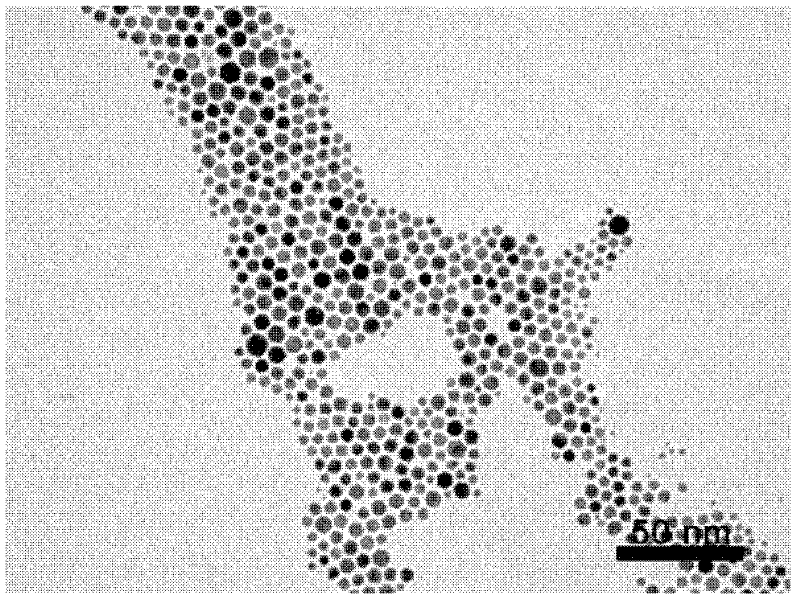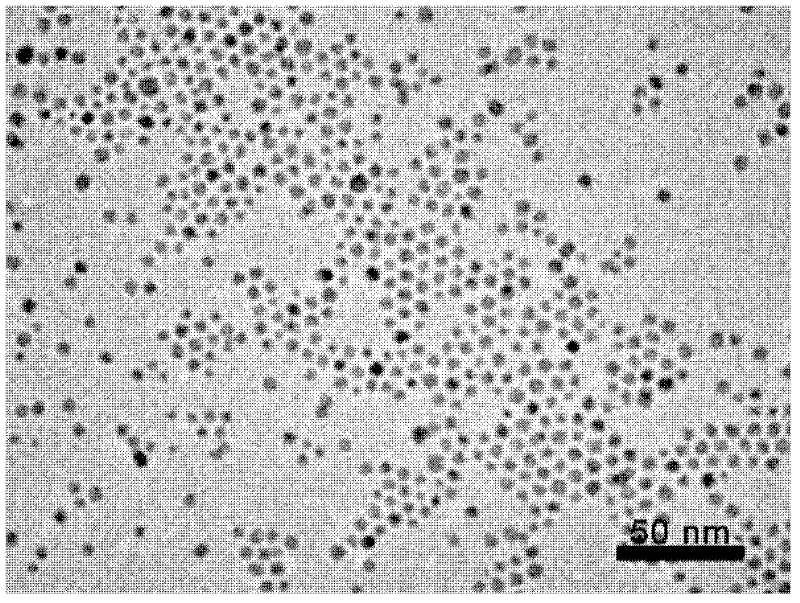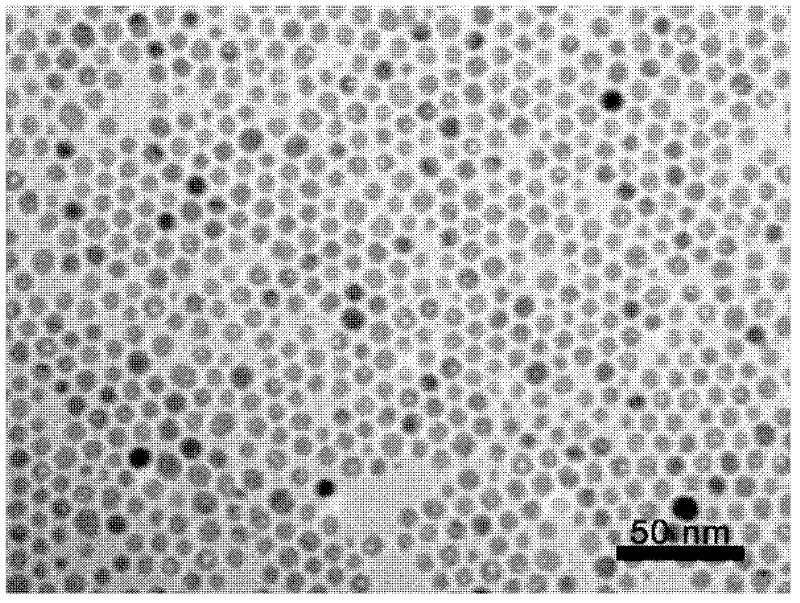Preparation method of polymer-coated binary bifunctional nanocluster core-shell microspheres
A technology of nanoclusters and polymers, applied in the field of composite nanoclusters, which can solve the problems of not realizing multifunctional integration and single function of nanoclusters
- Summary
- Abstract
- Description
- Claims
- Application Information
AI Technical Summary
Problems solved by technology
Method used
Image
Examples
Embodiment 1
[0043] 1. Synthesis of toluene-phase Au nanoparticles
[0044] First, Au nanoparticles stabilized by octadecyl p-vinylbenzyl-dimethylammonium chloride (OVDAC) were prepared by a water / chloroform two-phase method: 5ml of HAuCl with a concentration of 30mmol / L was mixed under stirring conditions. 4 Add the aqueous solution of 15ml to the chloroform solution containing 105mg OVDAC, after stirring vigorously for 30min, drop into 4.35ml containing 63.5mg NaBH 4 The aqueous solution was stirred for 30 min, and after the reaction was finished, the chloroform phase solution was separated with a separatory funnel. The chloroform in the system was removed by volatilization and 15ml of toluene was added to obtain Au nanoparticles with a toluene phase concentration of 10 mg / ml stabilized by OVDAC, as shown in Figure 1(a), indicating that we successfully synthesized the toluene phase Oil-soluble Au nanoparticles with a particle size of 10.4nm.
[0045] 2. Synthesis of toluene-phase Fe 3...
Embodiment 2
[0054] 1. Synthesis of Ag nanoparticles in toluene phase
[0055] First, Ag nanoparticles stabilized by OVDAC were prepared by a water / chloroform two-phase method: 5ml of AgNO with a concentration of 30mmol / L was mixed under stirring conditions. 3 The aqueous solution was added to 15ml of chloroform solution containing 105mg OVDAC, after vigorous stirring for 30min, 4ml containing 21mg NaBH 4 The aqueous solution was stirred for 30 min, and after the reaction was finished, the chloroform phase solution was separated with a separatory funnel. Chloroform in the system was removed by volatilization and 15 ml of toluene was added to obtain Ag nanoparticles with toluene phase concentration of 10 mg / ml stabilized by OVDAC. As shown in Figure 1(c), it shows that we have successfully synthesized oil-soluble Ag nanoparticles in toluene phase with a particle size of 7.8nm.
[0056] 2. Toluene phase Fe 3 o 4 The synthetic method of nanoparticles is as described in Example 1
[0057]...
Embodiment 3
[0064] 1. Synthesis of Pt nanoparticles in toluene phase
[0065] Firstly, OVDAC-stabilized Pt nanoparticles were prepared by a water / chloroform two-phase method: 3ml of 35mmol / L H 2 PtCl 6 The aqueous solution was added to 9ml of chloroform solution containing 69mg OVDAC, after vigorous stirring for 30min, 2.5ml of chloroform solution containing 51mgNaBH was added dropwise. 4 The aqueous solution was stirred for 30 min, and after the reaction was finished, the chloroform phase solution was separated with a separatory funnel. The chloroform in the system was removed by volatilization, and 9 ml of toluene was added to obtain Pt nanoparticles with a toluene phase concentration of 10 mg / ml stabilized by OVDAC. As shown in Fig. 1(d), we successfully synthesized oil-soluble Pt nanoparticles in toluene phase with a particle size of 2.1 nm.
[0066] 2. Toluene phase Fe 3 o 4 The synthetic method of nanoparticles is as described in Example 1
[0067] 3. Preparation of Fe 3 o 4...
PUM
| Property | Measurement | Unit |
|---|---|---|
| concentration | aaaaa | aaaaa |
| concentration | aaaaa | aaaaa |
| particle diameter | aaaaa | aaaaa |
Abstract
Description
Claims
Application Information
 Login to View More
Login to View More - R&D
- Intellectual Property
- Life Sciences
- Materials
- Tech Scout
- Unparalleled Data Quality
- Higher Quality Content
- 60% Fewer Hallucinations
Browse by: Latest US Patents, China's latest patents, Technical Efficacy Thesaurus, Application Domain, Technology Topic, Popular Technical Reports.
© 2025 PatSnap. All rights reserved.Legal|Privacy policy|Modern Slavery Act Transparency Statement|Sitemap|About US| Contact US: help@patsnap.com



